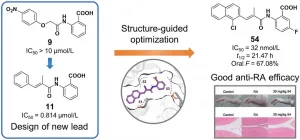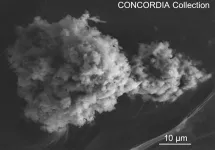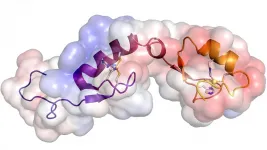Energy transmission by gold nanoparticles coupled to DNA structures
2021-04-08
(Press-News.org) Using DNA structures as scaffolds, Tim Liedl, a scientist of Ludwig-Maximilians-Universitaet (LMU) in Munich, has shown that precisely positioned gold nanoparticles can serve as efficient energy transmitters.
Since the inception of the field in 2006, laboratories around the world have been exploring the use of 'DNA origami' for the assembly of complex nanostructures. The method is based on DNA strands with defined sequences that interact via localized base pairing. "With the aid of short strands with appropriate sequences, we can connect specific regions of long DNA molecules together, rather like forming three-dimensional structures by folding a flat sheet of paper in certain ways," as Professor Tim Liedl of the Faculty of Physics at LMU explains.
Image and mirror image
Liedl has now used DNA origami to construct chiral objects, i.e. structures that cannot be superimposed by any combination of rotation and translation. Instead they possess 'handedness', and are mirror images of one another. Such pairs often differ in their physical properties, for example, in the degree to which they absorb polarized light. This effect can be exploited in many ways. For example, it is the basis for CD spectroscopy (the 'CD' here stands for 'circular dichroism'), a technique that is used to elucidate the overall spatial configuration of chemical compounds, and even whole proteins.
With a view to assembling chiral metal structures, Liedl and his group synthesized complex DNA-origami structures that provide precisely positioned binding sites for the attachment of spherical and rod-shaped gold nanoparticles. The scaffold therefore serves as a template or mold for the placement of nanoparticles at predetermined positions and in a defined spatial orientation. "One can assemble a chiral object based solely on the arrangement of the gold nanoparticles," says Liedl
Gold is not only chemically robust, as a noble metal it exhibits what are known as surface plasmon resonances. Plasmons are coherent electron oscillations that are generated when light interacts with the surface of a metal structure. "One can picture these oscillations as being like the waves that are excited when a bottle of water is shaken either parallel or at right angles to its long axis," says Liedl.
Gold nanoparticles as energy transmitters
Oscillations excited in spatially contiguous gold particles can couple to one another, and the plasmons in Liedl's experiments behave as image and mirror image, thanks to their chiral disposition on the origami scaffold. "This is confirmed by our CD spectroscopic measurements," says Liedl. In the experiments, the chiral structures are irradiated with circularly polarized light and the level of absorption is measured as a percentage of the input. This enables right- and left-handed arrangements to be distinguished from one another.
In principle, two gold nanorods should be sufficient for the construction of chiral object, as they can be arranged either in the form of an L or an inverted L. However, the rods used in the experiments were relatively far apart (on the nanoscale) and the plasmons excited in one had little effect on those generated in the other, i.e. the two hardly coupled to each other at all. But Liedl and his colleagues had a trick up their sleeves. By appropriate redesign of the origami structure, they were able to position a gold nanosphere between the pair of L-formed rods, which effectively amplified the coupling. CD spectroscopy revealed the presence of energy transitions, thus confirming the hypothesis which the team had derived from simulations.
Liedl envisages two potential settings in which these nanostructures could find practical application. They could be used to detect viruses, since the binding of viral nucleic acids to a gold particle will amplify the CD signal. In addition, chiral plasmonic transmitters could serve as model switching devices in optical computers, in which optical elements replace the transistors that are the workhorses of electronic computers.
INFORMATION:
ELSE PRESS RELEASES FROM THIS DATE:
2021-04-08
It's like something out of science fiction. Research led by Bigelow Laboratory for Ocean Sciences has revealed that a group of microbes, which feed off chemical reactions triggered by radioactivity, have been at an evolutionary standstill for millions of years. The discovery could have significant implications for biotechnology applications and scientific understanding of microbial evolution.
"This discovery shows that we must be careful when making assumptions about the speed of evolution and how we interpret the tree of life," said Eric Becraft, the lead author on the paper. "It is possible that some organisms go into an evolutionary ...
2021-04-08
Design, synthesis, molecular modeling, and biological evaluation of acrylamide derivatives as potent inhibitors of human dihydroorotate dehydrogenase for the treatment of rheumatoid arthritis
Human dihydroorotate dehydrogenase (DHODH) is a viable target for the development of therapeutics to treat cancer and immunological diseases, such as rheumatoid arthritis (RA), psoriasis and multiple sclerosis (MS).
The authors designed and synthesized a series of acrylamide-based novel DHODH inhibitors as potential RA treatment agents. 2-Acrylamidobenzoic acid analog 11 was identified as the lead compound for structure-activity ...
2021-04-08
Orchids of the Boreal zone are rare species. Most of the 28,000 species of the Orchid family actually live in the tropics. In the Boreal zone, ground orchids can hardly tolerate competition from other plants -- mainly forbs or grasses. So they are often pushed into ecotones -- border areas between meadows and forests, or between forests and swamps.
Furthermore, there has been a decline in wild orchids all over North America and Eurasia, caused in part by human-induced destruction of their habitats, the transformation of ecosystems, and the harvesting of flowers from the wild.
In the Novosibirsk region, ...
2021-04-08
Pioneering research led by experts from the University of Exeter's Living Systems Institute has provided new insight into formation of the human embryo.
The team of researchers discovered an unique regenerative property of cells in the early human embryo.
The first tissue to form in the embryo of mammals is the trophectoderm, which goes on to connect with the uterus and make the placenta. Previous research in mice found that trophectoderm is only made once.
In the new study, however, the research team found that human early embryos are able to regenerate trophectoderm. They also showed that human embryonic stem cells grown in the laboratory can similarly ...
2021-04-08
Every year, our planet encounters dust from comets and asteroids. These interplanetary dust particles pass through our atmosphere and give rise to shooting stars. Some of them reach the ground in the form of micrometeorites. An international program conducted for nearly 20 years by scientists from the CNRS, the Université Paris-Saclay and the National museum of natural history with the support of the French polar institute, has determined that 5,200 tons per year of these micrometeorites reach the ground. The study will be available in the journal Earth & Planetary Science Letters from April 15.
Micrometeorites have always fallen on our planet. These interplanetary dust particles from comets or asteroids are particles of a few tenths to hundredths of a millimetre that have passed ...
2021-04-08
Scientists have made a pivotal breakthrough in understanding the way in which cells communicate with each other.
A team of international researchers, including experts from the University of Exeter's Living Systems Institute, has identified how signalling pathways of Wnt proteins - which orchestrate and control many cell developmental processes - operate on both molecular and cellular levels.
Various mechanisms exist for cells to communicate with each other, and many are essential for development. This information exchange between cells is often based on signalling proteins that activate specific intracellular signalling cascades to control cell behaviour at a distance.
Wnt proteins are produced by a relatively small group ...
2021-04-08
The damaging effects of life under Nazi rule have long been known with many victims having experienced periods of protracted emotional and physical torture, malnutrition and mass exposure to disease. But recent research from the Hebrew University of Jerusalem show that even for those who survived, their health and mortality continued to be directly impacted long after the end of the Holocaust.
The study, led by Drs. Iaroslav Youssim and Hagit Hochner from the School of Public Health at the Faculty of Medicine and published in the American Journal of Epidemiology, investigated mortality rates from ...
2021-04-08
Short pieces of DNA--jumping genes--can bounce from one place to another in our genomes. When too many DNA fragments move around, cancer, infertility, and other problems can arise. Cold Spring Harbor Laboratory (CSHL) Professor & HHMI Investigator Leemor Joshua-Tor and a research investigator in her lab, Jonathan Ipsaro, study how cells safeguard the genome's integrity and immobilize these restless bits of DNA. They found that one of the jumping genes' most needed resources may also be their greatest vulnerability.
The mammalian genome is full of genetic elements that have the potential to move from place to place. One type is an LTR retrotransposon (LTR). In normal cells, these elements don't ...
2021-04-08
ITHACA, N.Y. - Research shows people turn to religion in times of fear and uncertainty - and March 2020 was one of those times.
To find the impact of religion during the early days of the COVID-19 pandemic in the United States, Landon Schnabel, the Robert and Ann Rosenthal Assistant Professor of Sociology in the College of Arts and Sciences, analyzed responses from 11,537 Americans surveyed March 19-24, 2020, shortly after the World Health Organization declared COVID-19 a global health pandemic.
Religion protected mental health of members of several ...
2021-04-08
Image inpainting is a computer vision technique in which pixels missing from an image are filled in. It is often used to remove unwanted objects from an image or to recreate missing regions of occluded images. Inpainting is a common tool for predicting missing image data, but it's challenging to synthesize the missing pixels in a realistic and coherent way.
Researchers at the University of Tokyo have presented a frequency-based inpainting method that enables the use of both frequency and spatial information to generate missing image portions. Publishing in the Journal of Electronic Imaging (JEI), Hiya Roy et al. detail the technique in " END ...
LAST 30 PRESS RELEASES:
[Press-News.org] Energy transmission by gold nanoparticles coupled to DNA structures





